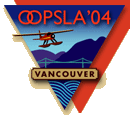
| Program |
 |
|
|
|
| Find in Program |
 |
|
|
|
| Page |
 |
|
|
|
| Basket |
 |
|
view, help
"Agile Requirements: Tailoring the Functional Requirements Specification Process to Improve Agility"
|
|
|

|
Agile Requirements: Tailoring the Functional Requirements Specification Process to Improve Agility
Meeting Room 16
Monday, 13:30, half day | 7 | · | 8 | · | 9 | · | 10 | · | 11 | · | 12 | · | 13 | · | 14 | · | 15 | · | 16 | · | 17 | · | 18 | · | 19 | · | 20 | · | 21 |
Jennitta Andrea, ClearStream Consulting: Jennitta Andrea (jennitta@agilecanada.com) has been a senior consultant with ClearStream Consulting since 1994 and has been a practitioner of XP and Scrum on over ten projects. Jennitta?s professional experience spans a variety of roles: agile process coach, requirements analyst, developer, customer quality advocate, instructor, and retrospective facilitator. Jennitta has published and presented at a variety of ven-ues, with an emphasis on process adaptation and automated acceptance testing (see www.agilecanada.com/wiki/Wiki.jsp?page=JennittaAndrea). Jennitta is an industrial trainer (2-day Automated Testing course; 3-day Agile Requirements course/workshop), and delivers simulation-based conference tutorials (Agile Re-quirements; Facilitating Effective Project Retrospectives).
Gerard Meszaros, ClearStream Consulting: Gerard Meszaros (gerard@gerardmeszaros.com) is Chief Scientist at ClearStream Consulting, where he leads teams applying agile software development techniques (such as eXtreme Programming) to help ClearStream's clients achieve faster and higher quality application development. He has presented successful tutorials at the past four OOPSLAs and has presented papers on automated testing and developing object oriented software frameworks at past XP and OOPSLA conferences.
Tutorial number: 34
Every project has different needs, goals, and constraints, so one size of requirements process does not fit all agile projects. This tutorial explores strategies for tuning the requirements process to optimize agility for a given set of project factors (e.g. team size, project complexity, project criticality, team knowledge and experience, stability and completeness of requirements, etc).
Topics discussed include:
- What work products do we need to use?
- How much detail is required?
- How formal does the communication channel, notation, and tools really need to be?
- Where is the hidden waste?
Beginner: This tutorial is appropriate for anyone wanting to specify functional requirements more efficiently, without sacrificing the effectiveness of their communication. Knowl-edge of common requirements artifacts such as use cases and UML notation is benefi-cial but not required.
|
